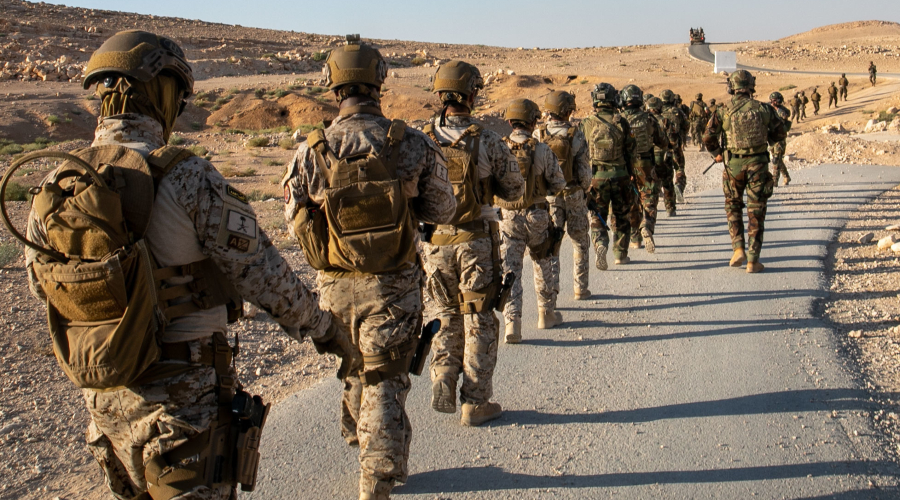Why Security Assistance Often Fails

Published by The Lawfare Institute
in Cooperation With

Editor’s Note: Around the world, the United States relies heavily on security assistance to gain influence and make its allies more formidable. When actual war breaks out, however, many long-time recipients of such assistance fight poorly or otherwise do not seem to have heeded the lessons that U.S. trainers tried to impart. The Naval War College’s Rachel Tecott Metz examines this track record, arguing that the United States relies too much on teaching and persuasion and should instead emphasize conditionality more.
Daniel Byman
***
The 20th anniversary of the U.S. invasion of Iraq has launched a set of reflections and recriminations over the decision to invade and subsequent bungling of the occupation. But another frustration with U.S. policy in Iraq deserves attention, as it has profound implications for U.S. policy today: the United States’ failure to build the Iraqi military. Building a competent Iraqi military was a pillar of the U.S. strategy to establish and maintain security in Iraq, which would enable U.S. forces to exit what was an increasingly unpopular war. Despite the centrality of the security assistance effort to U.S. foreign policy—the billions of dollars, eight years, and tens of thousands of personnel dedicated to the task—the Iraqi military never developed basic battlefield proficiency, and in the summer of 2014, less than three years after the U.S. withdrawal, the Iraqi Army’s 2nd Division melted away in the face of small numbers of lightly armed Islamic State fighters. U.S. troops returned hastily to Iraq and continue to train, advise, and equip the Iraqi military today, 20 years after they began. The problem with building competent security forces is not limited to this particularly prominent case—it plagues U.S. and allied efforts around the world, and understanding what went wrong in Iraq may improve outcomes with other partners as well.
The Mixed Record of Security Assistance
Building competent partner militaries was central to the U.S. war efforts in Iraq, Afghanistan, and Vietnam. Today, the United States trains, equips, and advises the Armed Forces of Ukraine to fight Russia and the Taiwanese Armed Forces to fight China. Beyond the headline cases, the United States provides some form of security assistance to almost every country in the world. The record of these efforts, however, is mixed at best.
Security assistance is difficult because military effectiveness depends not only on what militaries have (or are given) in material terms and how troops are trained at the tactical level but also on patterns of decisions that leaders make. And leaders—especially those likeliest to receive security assistance from the United States, who may be facing societal upheaval, insurgency, and civil war—may prioritize preventing coups, consolidating political power, personal enrichment, or personal survival above the strength of their nation’s military. In practice, this means that leaders may promote loyal officers instead of competent ones, permit corruption, and neglect training. As I have written elsewhere, “They might welcome huge infusions of cash, equipment, and assistance from the United States, while simultaneously ignoring U.S. advice and implementing policies that keep their militaries weak.” Even in Ukraine, now a security assistance success story, Ukrainian leadership neglected to implement vital reforms of the corrupt procurement system until after Russia’s full-scale invasion in February 2022, leaving the Ukrainian military short of the Stugna anti-tank missiles they needed to fight the Russians.
The Challenge Is Influence
Fundamentally, then, the central challenge for those trying to build better militaries in partner states is influencing partner leadership. The United States builds better militaries when partner leaders implement the vital policy reforms the United States recommends, and U.S. security assistance fails when U.S. influence fails.
In research published recently in International Security, I conceptualize U.S. strategies of influence in security assistance as an influence escalation ladder with four rungs: teaching, persuasion, conditionality (incentives), and direct command. A teaching approach aims to influence recipient leaders by providing them with information they may need to improve the effectiveness of their militaries. Persuasion refers to several approaches advisers can take to shape recipient leader thinking and behavior: positive inducements, such as increases in assistance with no strings attached; good old-fashioned argument; demonstrating “what right looks like”; and rapport-building. Persuasion is essentially a theory of influence through personal diplomacy. A conditionality approach to influence aims to incentivize policy reforms by, for instance, promising recipient leaders increases in assistance and/or threatening to reduce assistance depending on the progress (or lack thereof) of their reforms. Whereas teaching, persuasion, and conditionality are indirect forms of influence, direct command (as the name implies) replaces partner decision-makers with U.S. ones in the partner chain of command.
Teaching, persuasion, conditionality, and direct command are not mutually exclusive. Advisers can rely entirely on teaching and persuasion, or they can combine teaching and persuasion with conditionality and/or direct command.
There is mounting evidence that conditionality is an important ingredient for effective influence and security assistance. There is also clear evidence that the United States relies almost entirely on teaching and persuasion, rarely using carrots and sticks to incentivize partners to implement the policy reforms necessary to strengthen their militaries.
The U.S. Reliance on Ineffective Strategies of Influence
The United States’ persistent reliance on ineffective strategies of influence in security assistance is puzzling. The conventional wisdom in the security assistance literature is that the United States rarely uses incentives because it lacks the monitoring capacity to detect when recipient leaders’ policies undermine their militaries, the bargaining power to motivate reforms, or both.
My research shows, in contrast, that U.S. military advisers are almost always acutely aware of when their counterparts disregard their advice and the implementation of policies that undermine the security assistance effort. Visibility is rarely—if ever—a limiting factor in security assistance. It also shows that the United States usually enjoys a great deal of bargaining power vis-a-vis its security assistance recipients. The puzzle is the United States’ consistent preference not to play its hand.
I present an alternative explanation, and demonstrate how the bureaucratic interests, ideologies, and standard operating procedures of the U.S. military organizations that design and implement U.S. security assistance programs lead them to rely, persistently, on strategies of influence that do not work.
The military organization responsible for the bulk of U.S. security assistance in Iraq, and a large portion of U.S. security assistance around the world, is the U.S. Army. The U.S. Army’s organizational essence is ground combat—despite rhetoric to the contrary, the U.S. Army does not consider security assistance to be a core mission. In conducting security assistance, the U.S. Army aims primarily to protect its combat mission, preserve its autonomy against civilian intrusion, and keep its standard operating procedures up and running with as little headache as possible. It puts these goals above the nominal aim of strengthening partner militaries.
The U.S. military relies on teaching and persuasion, and rarely uses incentives or direct command, because reliance on teaching and persuasion serves its bureaucratic objectives, whereas conditionality or direct command threatens them.
Within the Army, and across the services, an ideology has evolved to promote and perpetuate teaching and persuasion and discourage conditionality in advisory missions. This emphasis on persuasion consists of the normative beliefs that teaching and persuasion are “right” and conditionality and direct command “wrong.” Conditionality and direct command are denigrated as bullying, neo-colonial, or otherwise incompatible with the philosophy that advisers should win their advisees’ cooperation through their example, logic, or friendship. The ideology also promotes the causal myths that teaching and persuasion work while conditionality and direct command backfire.
In the International Security article, I show how these bureaucratic dynamics contributed to the United States’ failure to build the Iraqi military into an effective force. Many Iraqi political and military leaders—often for understandable reasons—prioritized coup-proofing, power consolidation, and parochial interests above strengthening the Iraqi military. U.S. general officers tasked with building the Iraqi military prioritized the combat mission above the advisory mission, optimized their advisory efforts for creating an appearance of progress over actual progress, and kept the bureaucratic gears of the advisory program turning smoothly even when they were turning toward failure. Senior officers continued to rely on teaching and persuasion and eschew incentives, and to espouse the normative and effective superiority of teaching and persuasion above conditionality and direct command, even as Iraqi leaders clearly and consistently ignored their advice, implementing policies that fatally undermined the Iraqi military.
Lessons for a Better Approach
It is vital to identify pathologies in the U.S. military’s approach to building a military in Iraq because security assistance has emerged as a central pillar of U.S. defense strategy, and much of the foundation for U.S. security assistance around the world today was laid in Iraq and Afghanistan. If current and future efforts, like those supporting Ukrainian and Taiwanese forces, are to be successful, they will need to learn from, not just replicate, the approach taken in those wars.
My research suggests several policy implications for U.S. security assistance. For one thing, it suggests that most of the policy reforms currently advocated by practitioners of security assistance are unlikely to succeed. Practitioners advocate for increased investments, longer advisory tours, and improvements in adviser training. But these reforms will have little effect on U.S. security assistance outcomes absent fundamental reform of the U.S. military’s basic approach to advising. At most, such changes could help on the margins, but they do not get to the root of the problems.
More than anything else, my research cautions humility. Security assistance is extremely difficult, and the odds of success depend largely on how motivated recipient leaders are to strengthen their militaries. Even the active war inside Ukraine’s borders from 2014 to 2022 was insufficient to motivate Ukrainian leadership to tackle corruption in defense procurement. It took the full-scale invasion in February 2022 and “the largest war on European soil since WWII to persuade Kyiv to embrace reform and maximize the value of U.S. assistance.”
My research also suggests that U.S. influence is more likely to fail when the United States relies entirely on teaching and persuasion, and more likely to succeed when the United States combines persuasion with conditionality to incentivize vital policy reforms. During the Korean War, for example, Korean Military Advisory Group (KMAG) advisers used their control of Republic of Korea Army (ROK Army) supplies and personnel appointments to incentivize ROK Army officers to follow their direction. This approach had positive results and, as I wrote for the Modern War Institute, “[b]y 1952, the U.S. Eighth Army secured the almost full cooperation of ROK leadership with respect to the development of the ROK Army, and the ROK Army transformed into an effective fighting force by the summer of 1953.”
Finally, the findings suggest that the U.S. military is unlikely to change its approach to building partner militaries on its own. The Department of Defense—and often U.S. military advisers in theater—increasingly bears the lion’s share of the responsibility for the design and implementation of U.S. military-building efforts around the world. U.S. civilian leadership tends to defer to the U.S. military’s approach, even when it becomes abundantly clear that efforts are stalling. Absent civilian pressure, and with the funding for military-building projects flowing liberally, the U.S. military has no incentive to rethink its approach. U.S. efforts to strengthen other countries’ militaries are inherently political, and U.S. civilian leaders can and should play a more active role, both by working more directly with recipient leaders to incentivize reforms and by more actively overseeing and directing the U.S. military to do the same.




